Proving the value of your SEO efforts can seem like an uphill battle.
What’s the cheat code to getting buy-in from stakeholders?
Tracking the right SEO KPIs. Not just the default ones in your dashboards. But the right metrics.
In this guide, you’ll learn how to choose and monitor SEO KPIs that actually mean something. I’ll show you:
- What makes an SEO metric a true KPI (and what doesn’t)
- Which SEO KPIs matter most and why
- Which emerging KPIs to track in the era of AI Overviews and LLM search
- How to select KPIs based on your goals and maturity stage
What Are SEO KPIs? (And What They’re Not)
SEO KPIs are key performance indicators that tie your optimization efforts directly to business outcomes. They measure whether or not your SEO strategy is achieving its overall purpose.
On the other hand, SEO metrics are more broad. They include all the available data you could monitor in SEO tools and analytics platforms.
But here’s the thing:
Just because you can measure a bunch of different metrics doesn’t mean you should treat them all as KPIs.
| SEO Metric | SEO KPI |
|---|---|
| Organic traffic | Demo signups from organic traffic |
| Bounce rate | Engagement on the page based by page type |
| Backlinks | Topical or brand authority growth |
Why You Need to Measure the Right SEO KPIs
Measuring your SEO KPIs over time is how you prove your SEO work is moving the business in the right direction.
Tracking the right KPIs can help you:
- Uncover blockers early: If conversions are dipping even though your traffic is increasing, you may have a content or UX issue.
- Make better decisions: Knowing which actions moved the needle (and when) helps you repeat tactics that work and avoid the ones that don’t.
- Discover much-needed pivots: Monitoring KPI-linked performance data makes it easier to adjust content, targeting, and resource investment.
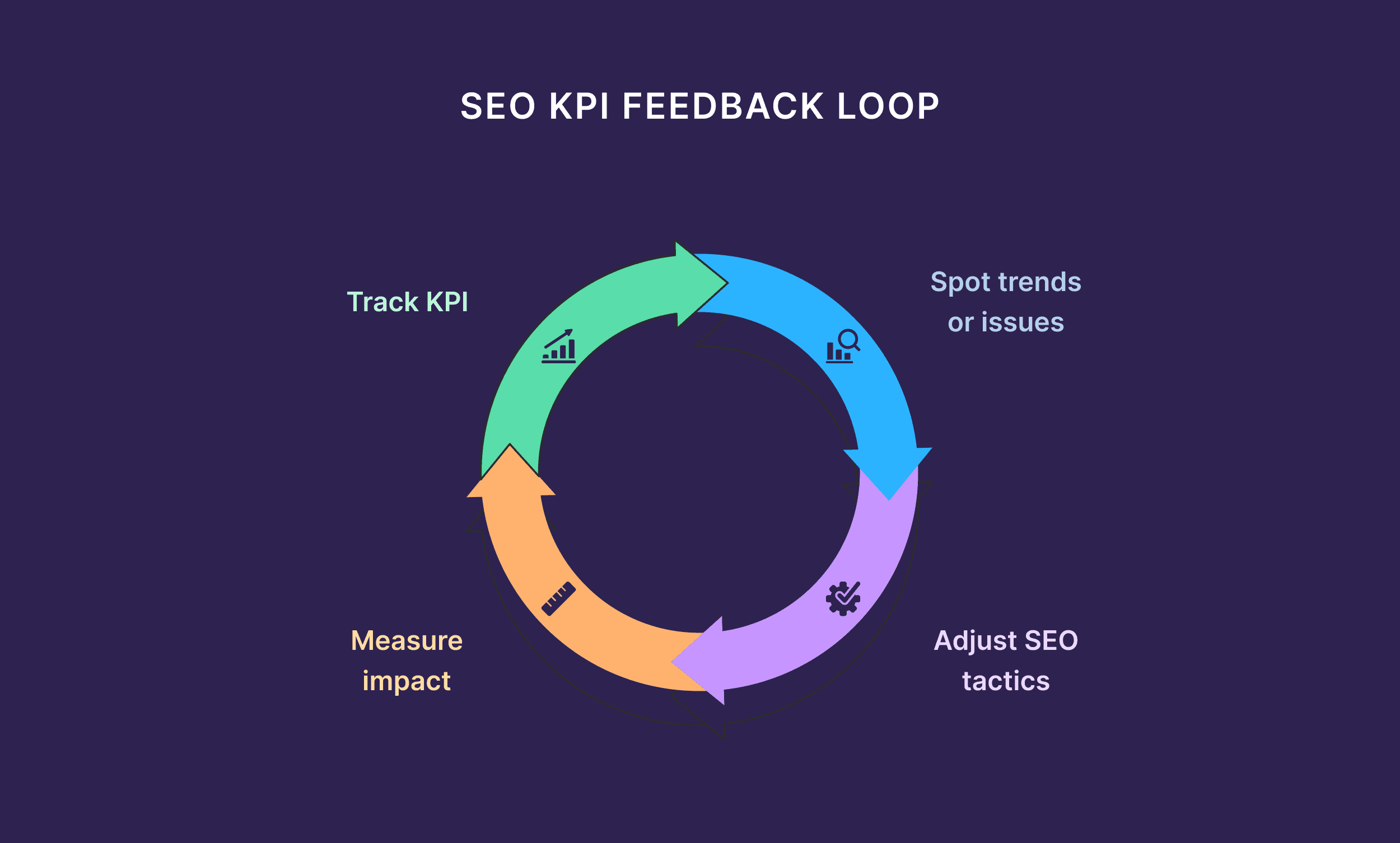
Let’s take a look at the KPIs that most effectively show how SEO is moving the business forward.
SEO KPIs That Prove You’re Doing Your Job
Which KPIs you choose to measure should reflect where your business is going and what SEO is expected to deliver along the way.
So, not all of the KPIs below are your KPIs. They depend on your specific business model, SEO maturity, and desired outcomes.
With that in mind, we created a free SEO KPI planner to help you build your own custom SEO KPI system.
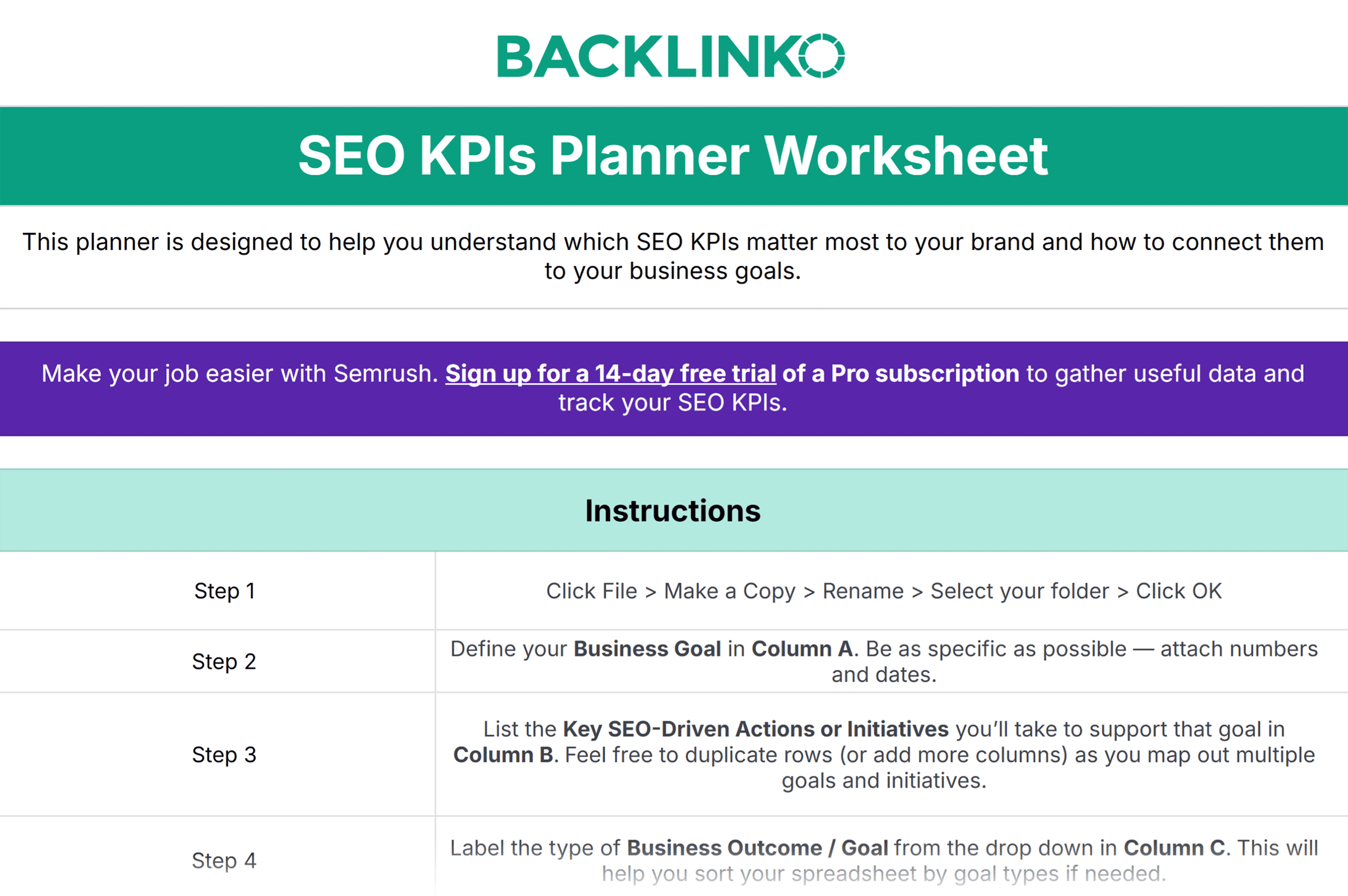
This worksheet is a brainstorming tool. It will help you connect your SEO actions to the KPIs you need to monitor to hit your business goals.
It’ll also help you avoid common mistakes like:
- Overreporting vanity metrics (e.g., rankings without conversion context)
- Ignoring conversions altogether
- Treating all SEO metrics as your SEO KPIs
- Failing to communicate SEO gains in terms the business cares about
Side note: Your KPIs might shift over time depending on whether you’re building brand awareness, driving conversions, or trying to improve user experience and engagement on the page. Use this planner to keep track of things as your business goals evolve.
Conversion and Revenue KPIs
You should track conversion or revenue-related KPIs no matter what stage of SEO investment you’re in.
Why?
Because these are the metrics most clearly tied to your larger goals of lead generation and revenue impact. In other words: goals that drive business growth.
| KPI | Definition | Why It Matters | How to Measure | Example |
|---|---|---|---|---|
| Organic-assisted conversions | Conversions where organic search appeared in the user’s journey, even if not the final touchpoint | Shows SEO’s role in the full customer journey | Attribution paths report in GA4 | Tracking how often organic content influences purchases (even when social or paid channels get last-click credit) |
| Demo or trial signups | Number of demos or trial signups attributed to organic search | Indicator of lead generation from SEO | Event tracking in GA4 with source segmentation | Monitoring improvements in signups after implementing new content strategy |
| Form opt-ins | Email signups and contact form submissions from organic traffic | Measures mid-funnel conversions | Event tracking in analytics; form analytics tools | Comparing form completion rates across different landing pages |
| Revenue from organic traffic | Earned revenue from organic search visitors | Measures SEO ROI | Ecommerce tracking in analytics; CRM integration for B2B | Determining quarterly organic revenue to justify increased SEO investment |
How to Track These KPIs
You’ll need to configure a tool like Google Analytics to track these types of SEO metrics based on your unique needs or goals.
For example, using the Attribution paths report to track organic-assisted conversions:

And the Key events feature to track conversions and signups:
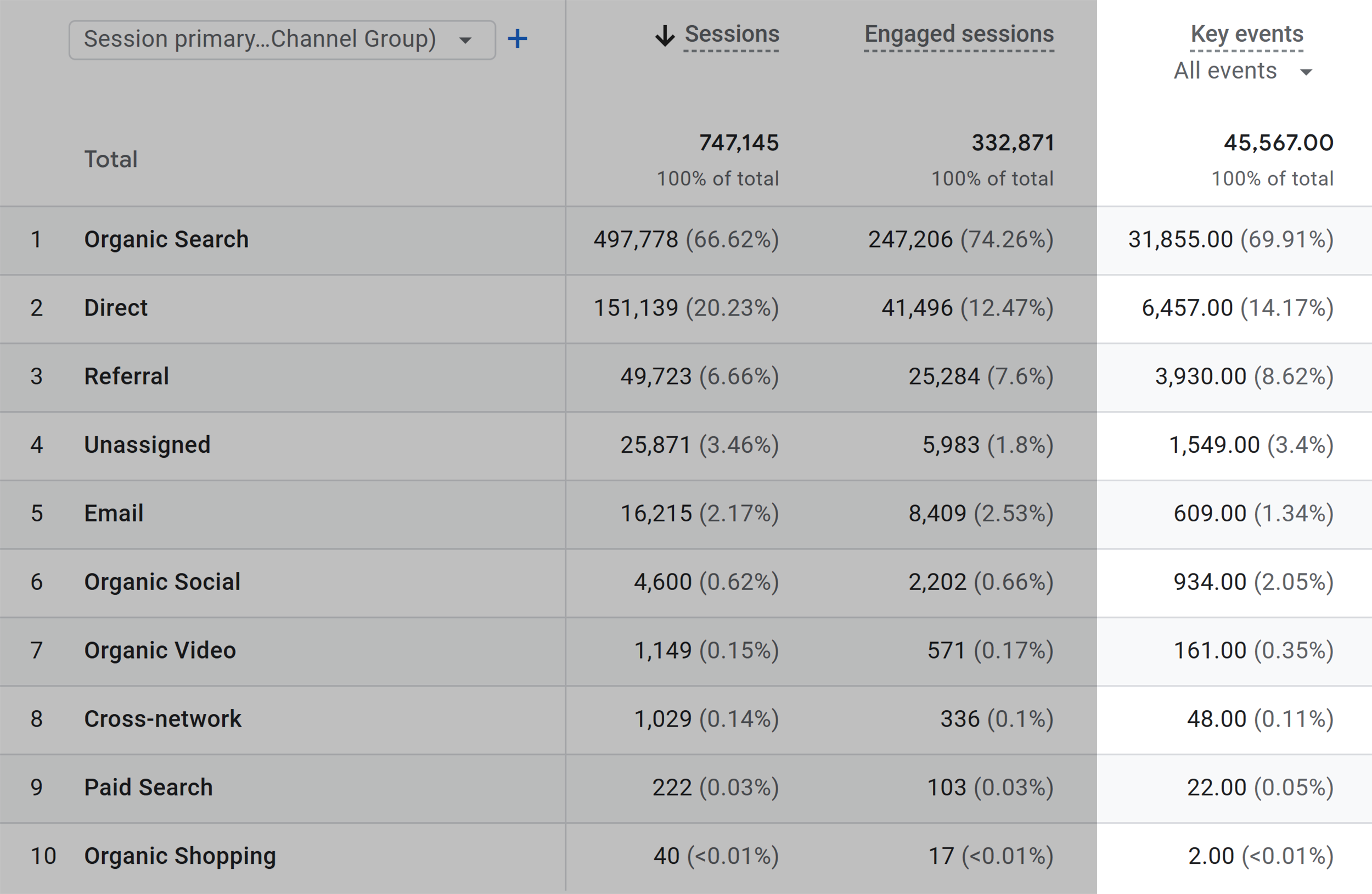
A Note on Tying SEO KPIs to Revenue
There’s some debate in the SEO community about KPIs that tie into business revenue.
I’ve had this discussion with marketing leaders many times:
Should you consider revenue-based SEO KPIs when determining if SEO efforts are successful?
Just take a quick afternoon stroll in the r/SEO subreddit, and you’ll encounter wildly different opinions regarding the tie between revenue and SEO performance.
Some will tell you that revenue-based KPIs are the only ones that matter:
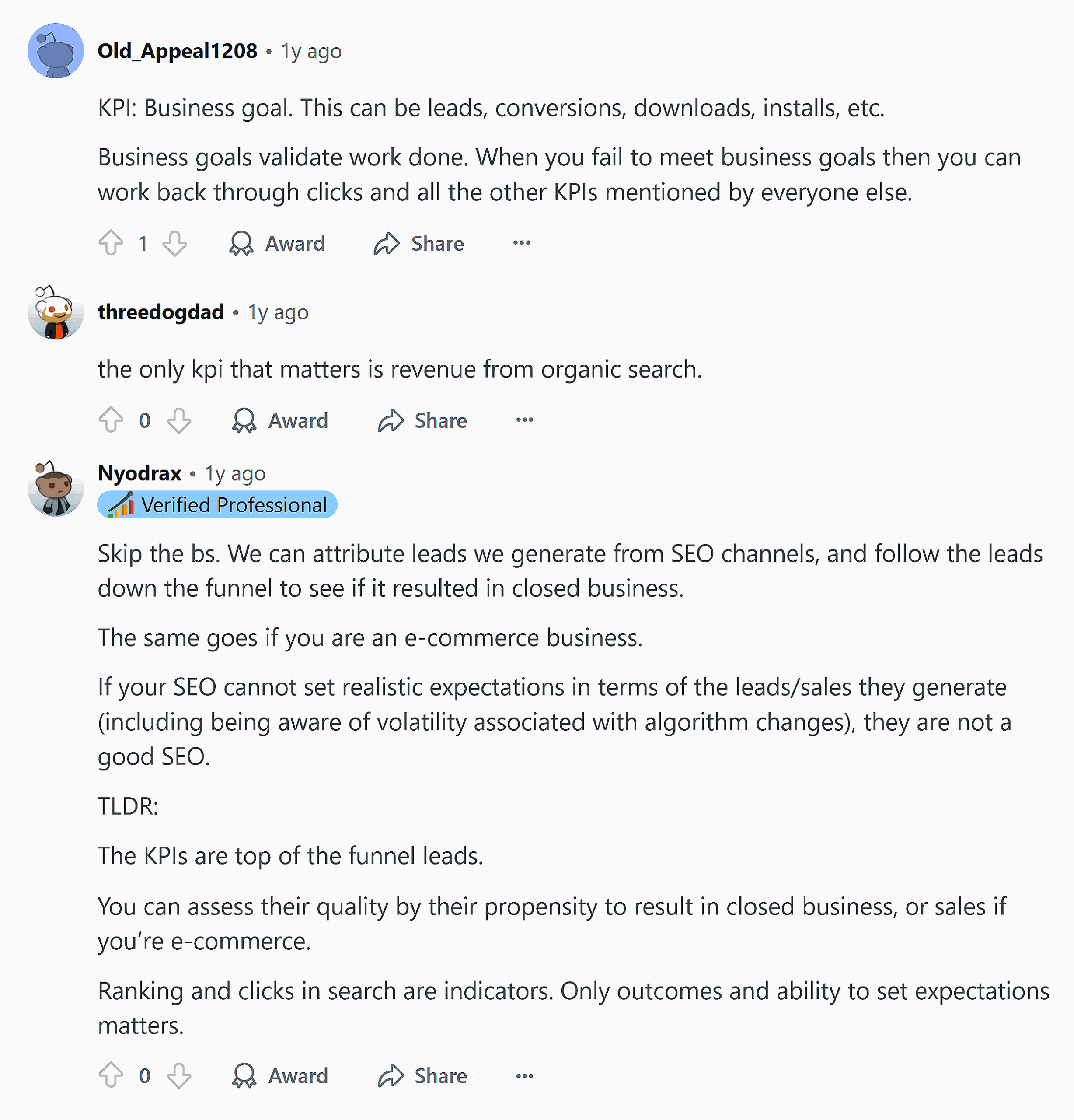
Others will tell you that all that matters is where you rank:
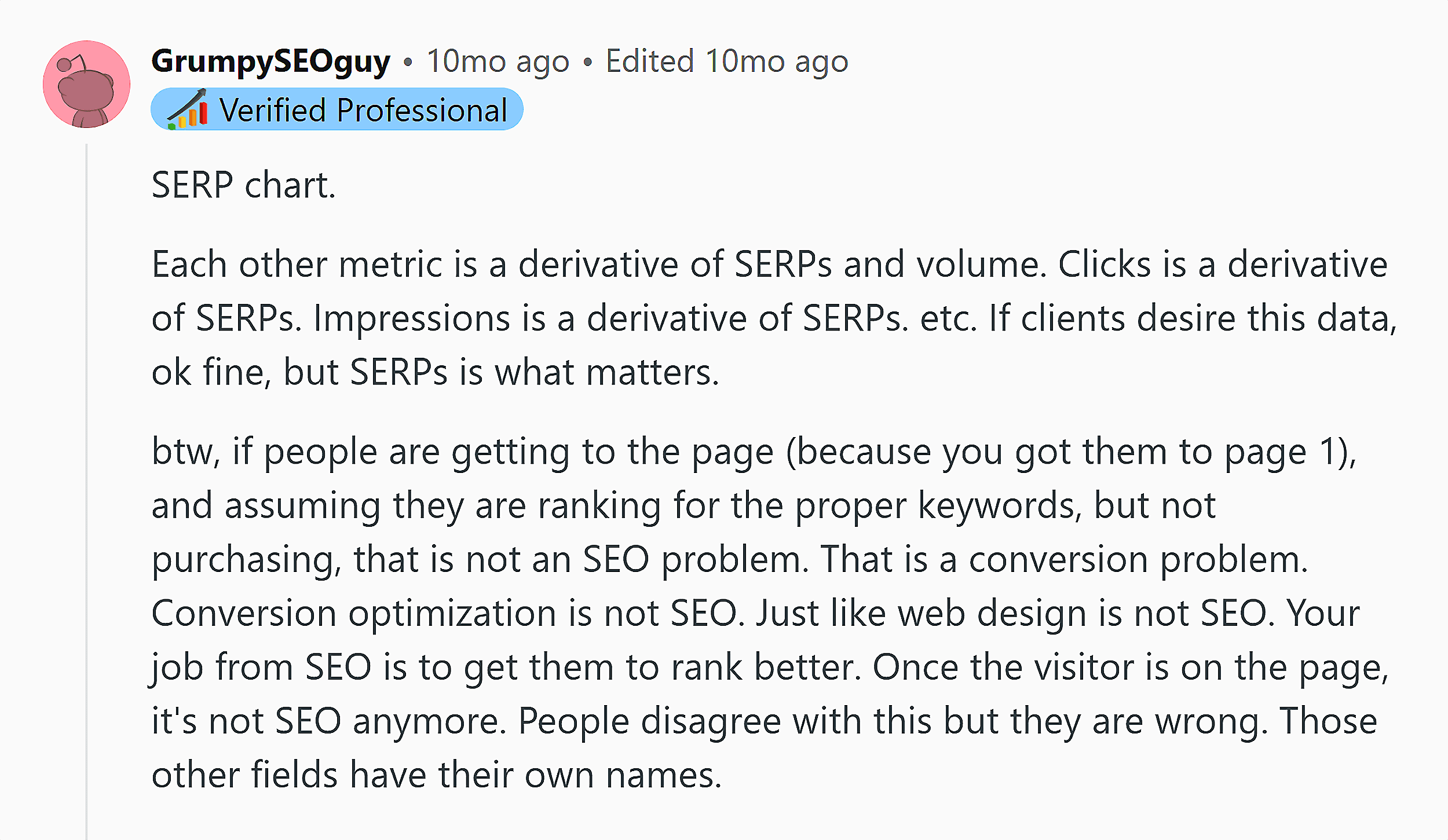
They’ll argue that KPIs based on revenue impact are unfair because an SEO team doesn’t control sales team outcomes, brand messaging, product improvements, or conversion rate optimization (CRO).
But:
You’re performing SEO to help the business gain online visibility and drive growth. As long as your KPIs are linked to these broad goals, they’re worth tracking.
Visibility and Awareness KPIs
SEO KPIs related to visibility and awareness are worth tracking if you’re trying to grow a brand.
But we’d argue they’re now essential for all brands to track — no matter the growth stage.
Why?
Because AI Overviews and other AI tools have changed the game. It’s no longer just about ranking at the top of Google. Being included in AI responses is going to become an increasingly important factor in your SEO success.
For example, here’s the SERP for “what’s the best crm”:

Notice how the “top” result is an AI Overview that immediately tells the user a few examples of CRMs.
Salesforce and HubSpot would never rank top for such a competitive term on their own. Appearing in an AI Overview gives them a new way to instantly appear as the right choice for a user searching for this term.
How do you increase your chances of appearing in these responses?
By boosting your brand visibility (among other things).
The specifics of how you can do that are a topic for another article. For now, here are some important SEO KPIs you can use to gauge your overall brand visibility:
| KPI | Definition | Why It Matters | How to Measure | Example |
|---|---|---|---|---|
| Organic impressions | Number of times your website appears in search results viewed by users | Indicates overall search visibility and potential reach | Google Search Console impressions data | Tracking impression growth in targeted categories following content expansion |
| Branded search | Searches for your brand name and variations | Indicates brand awareness | Google Search Console; Semrush’s Domain Overview (useful for comparing to competitors) | Measuring correlation of TV campaign on branded search volume |
| SERP feature ownership | Visibility in featured snippets, knowledge panels, People Also Ask boxes etc. | Indicates growing authority signals | SERP feature tracking tools, like Semrush Position Tracking | Monitoring featured snippet acquisition after implementing FAQ schema |
How to Track These KPIs
You can use Google Search Console to monitor organic impressions:
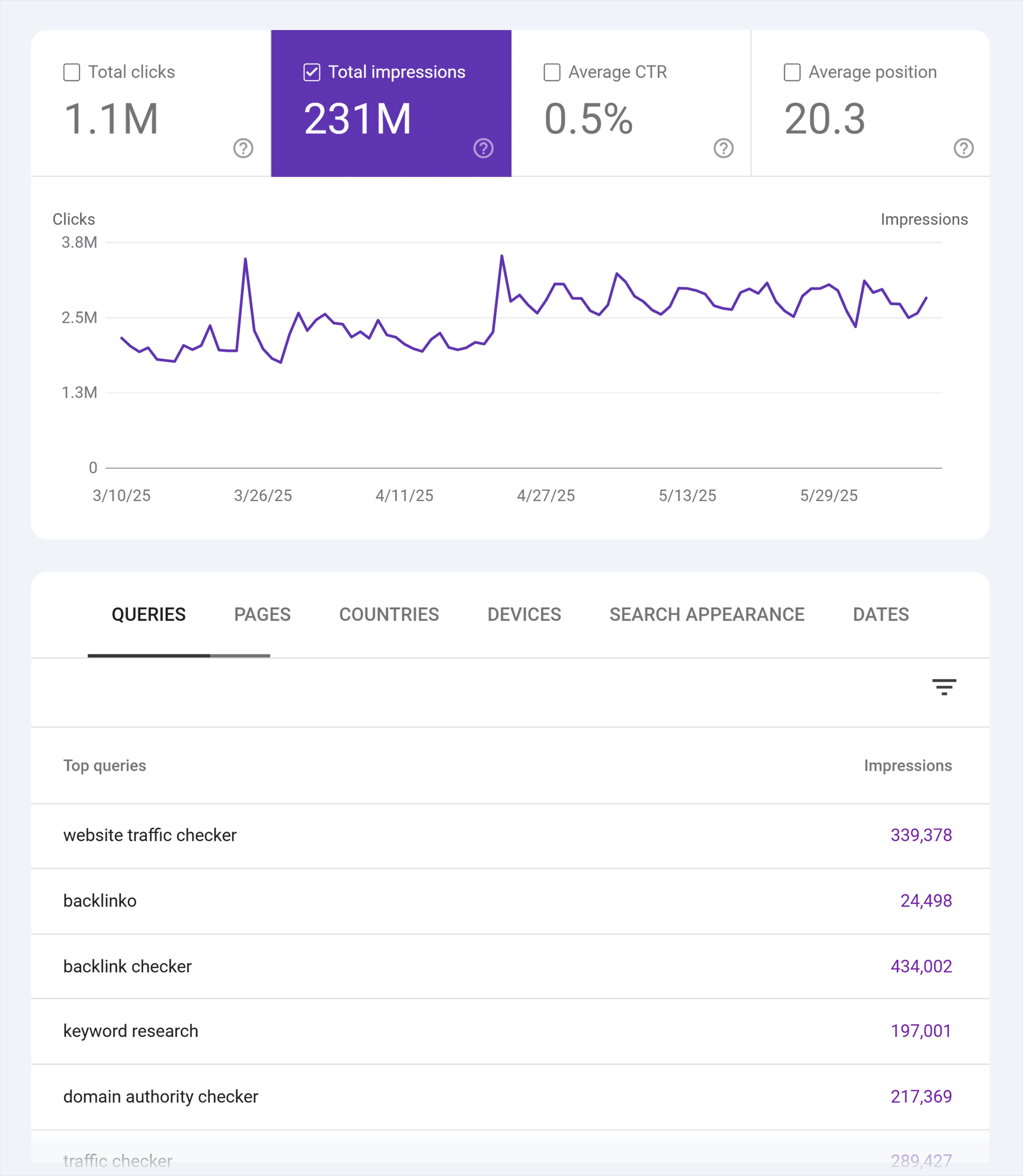
You can also use it to track branded search visibility:

To monitor SERP feature ownership, you can use Semrush’s Position Tracking tool. It shows you which SERP features you appear in for your custom-tracked keywords.

Note: A free Semrush account lets you track up to 10 keywords. Or you can use this link to access a 14-day trial on a Semrush Pro subscription.
Who Should Use These KPIs?
Visibility and awareness KPIs usually include metrics that measure larger goals of brand visibility and authority building. While they’re worth tracking for all brands, they’re particularly important for:
- Early-stage and growth-stage orgs that prioritize brand authority investment
- A small business that just started investing in SEO and marketing
- Established sites that have seen a noticeable decline in branded search
Engagement and Behavior KPIs
You’ll want to monitor engagement and behavior KPIs once you’re past the initial investment in SEO and into stages of SEO growth or maturity. You’re getting decent traffic, and now you want to optimize the site to better engage that traffic.
| KPI | Definition | Why It Matters | How to Measure | Example |
|---|---|---|---|---|
| Click-through rate (CTR) | Percentage of impressions that result in clicks to your site | Indicates relevance of content to search intent | Google Search Console CTR metrics | Monitoring CTR improvements on pages with new title tags |
| Scroll depth / engaged sessions | How far users scroll; sessions with on-page engagement | Measure of content relevance and quality | GA4 engaged sessions | Measuring engagement for mid-funnel pages after content restructuring |
| Pages per session | Average number of pages users view during a session | Indicates content interest and sufficient site structure | Analytics platforms (GA4 calls it “Views per session”) | Analyzing the effectiveness of updated internal linking strategy |
| Average engagement time | Time users spend actively engaging with content | Indicates how well content engages and keeps users interested | GA4 engagement time | Determining which topics on the site hold user attention to guide content strategy |
| On-page “hot spots” | Visual indicators of where users focus attention | Reveals actual user behavior | Heatmaps and click maps (using tools like Hotjar, VWO) | Monitoring where and when users drop off |
How to Track These KPIs
GA4 has a lot of built-in ways to monitor KPIs related to user behavior and engagement:

But you’ll need to use a specialized tool like Hotjar to monitor more granular page engagement:

Who Should Use These KPIs?
Your team should measure engagement and behavior KPIs to monitor progress toward goals related to lead generation, revenue impact, and authority building.
Here are a few example scenarios where you’d want to measure these KPIs:
- SEO teams that focus on driving up on-page engagement
- Businesses that need to determine which content topics are resonating with their audience
- Organizations that have built a content library but are noticing underperformance
- Any team facing low conversion rates with no obvious cause
Authority and Ranking Power KPIs
If topical authority or share of voice drives your strategy, track these ranking-power KPIs:
| KPI | Definition | Why It Matters | How to Measure | Example |
|---|---|---|---|---|
| Referring domains or backlinks | Number of external websites linking to your site | External signal of site authority | Semrush Backlink Analysis and Backlink Audit | Benchmarking authority backlinks earned from digital PR campaign |
| Ranking content percentage | Portion of indexed content ranking in target positions | Indicates content quality and optimization effectiveness | SERP tracking tools with position filtering (like Semrush Position Tracking) | Monitoring content library pages ranking in positions 1-3 for target topics |
| Share of voice in key topic clusters | Visibility compared to competitors for core topic areas | Shows topical authority and competitive position | SERP visibility tools, like Position Tracking | Measuring share-of-voice compared in core topics after content refresh |
| Average SERP ranking positions | Average position of rankings across tracked keywords | Overall indicator of search visibility | Google Search Console; rank tracking tools with averaging capabilities | Benchmarking growth in top SERP rankings over time for core keywords |
How to Track These KPIs
You’ll generally need more specialized tools to track these KPIs. Semrush’s Backlink Analytics shows lots of metrics about your site’s authority.
These include total numbers and trends of backlinks and referring domains:

Rank tracking tools like Semrush’s Position Tracking can help you work out the percentage of your key content that ranks in target positions. And you can even get at-a-glance data about your share of voice:

Finally, use Google Search Console to track your average ranking positions at the page or query level:

Who Should Use These KPIs?
Authority and ranking power KPIs are important for teams working toward brand visibility and authority building goals. Examples include:
- Organizations that prioritize backlink and digital PR investment
- Teams that are investing in growing their topical authority or increased topic ownership
- Established sites that have organic visibility but want to outpace competitors
Emerging SEO KPIs for the AI Era
So much has changed in SEO since the introduction of AI and LLM-based chat and search functions.
And with all this change comes the need to adjust how we monitor SEO success for our stakeholders, teams, and clients.
If you want to show up at key AI-powered search moments, start tracking these new KPIs for AI mentions and visibility:
| KPI | Definition | Why It Matters | How to Measure | Example |
|---|---|---|---|---|
| LLM mentions | Frequency of brand/product mentions in AI response outputs | Indicates visibility in the growing AI search ecosystem | Manual testing; Semrush AI SEO Toolkit | Monitoring increased brand mentions via LLM models after implementing structured data |
| AIO visibility and inclusion rate | Presence in Google’s AI Overviews | Critical for visibility in AI-enhanced SERPs | Manual tracking; Semrush Position Tracking | Benchmarking growth in AIO optimizations for high-value queries |
| Topic authority | Demonstrates the relevance of your domain to the topic of a selected seed keyword | Indicates potential for ranking in key topic areas | SEO tools with topical authority metrics, like Semrush; custom scoring | Determining increased authority in specific targeted topics |
| LLM-driven traffic | Visitors coming from AI search channels | Measures impact of AI tools as a new traffic channel | GA4 with source identification; UTM parameters | Using GA4 and/or UTM tagging to monitor organic traffic from LLMs |
How to Track These KPIs
Tracking AI mentions is still a bit tricky at the moment. You can see some referral traffic from sites like ChatGPT in your Google Analytics account:

But monitoring your brand’s inclusion in AI Overviews might be easier than you think.
Using Semrush’s Position Tracking tool, you can filter keywords by those for which you rank in the AI Overview:
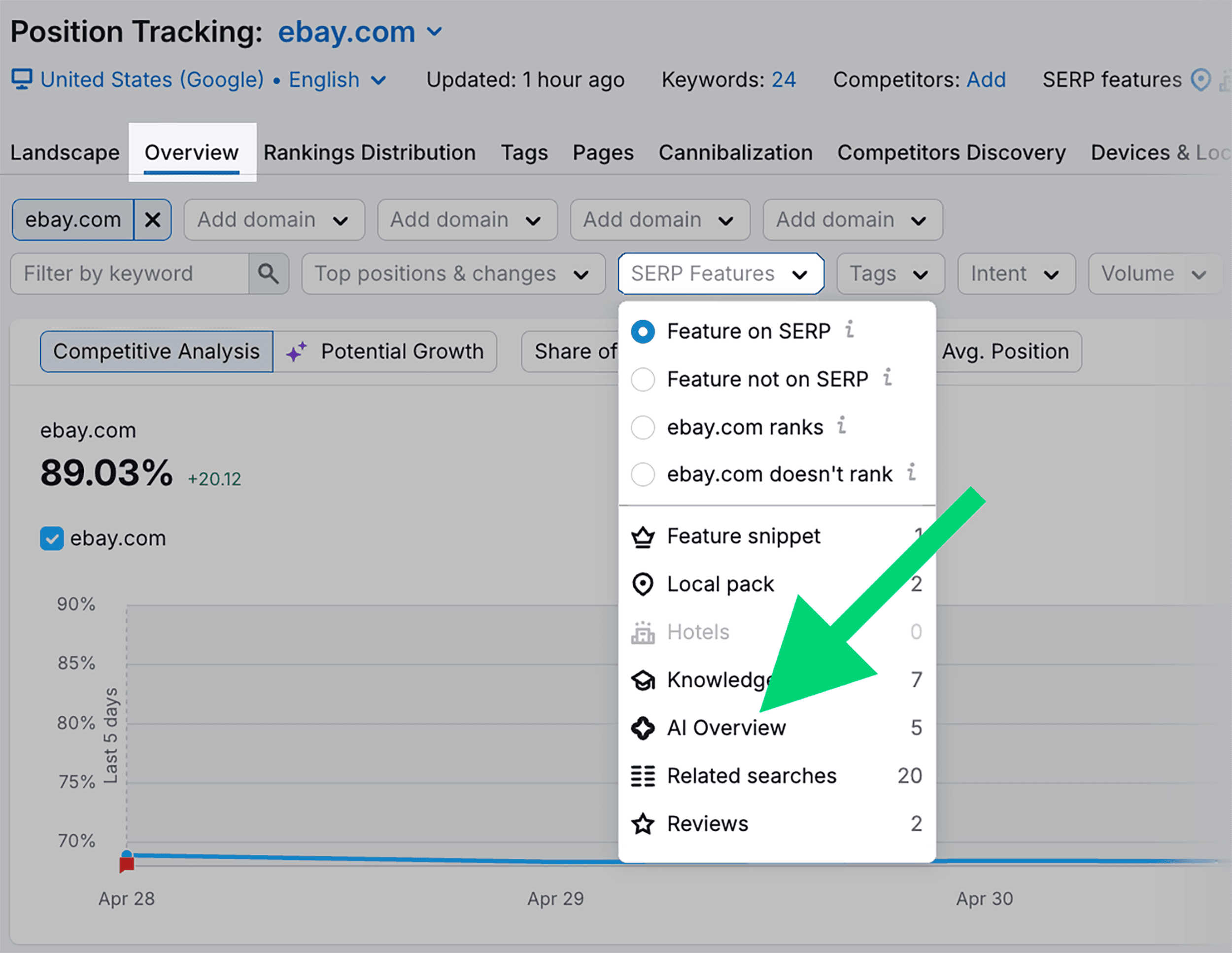
How to Choose the Right SEO KPIs for Your Business
Now that you know what SEO KPIs you could track, you need to connect the dots between your business goals and the SEO metrics that matter most.
Use these four approaches (alone or combined) to zero in on the KPIs that matter most to your team.
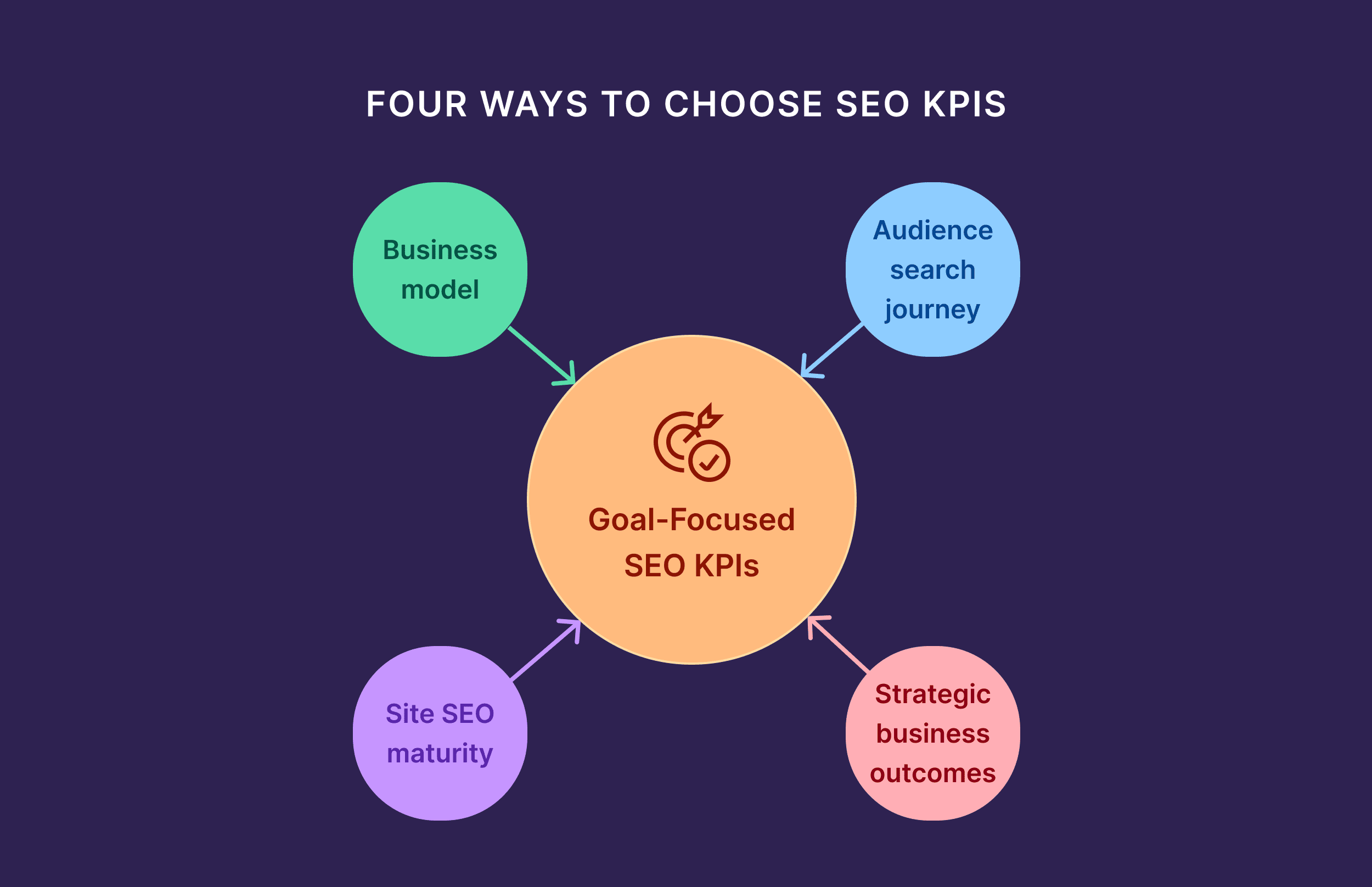
1. Align KPIs to Your Business Model
The way your business operates has a direct impact on which metrics signal success.
For example, a local HVAC service provider and a global SaaS company won’t measure SEO wins the same way.
Here are a few examples of how you might prioritize SEO KPIs based on different business models:
- Small ecommerce site: Focus on revenue per organic visit, product page visibility in SERPs, and even top-of-the-funnel indicators like newsletter opt-ins or coupon searches.
- Startup SaaS platform: Track branded search growth, demo or free trial signups from organic visits, and the performance of long-tail, solution-focused keywords.
- Service-based businesses: Monitor metrics tied to future conversions, like free consultation forms, quote requests, and engagement indicators like page views per session.
- Local businesses: Prioritize local visibility KPIs like Map Pack presence, Google reviews, and organic visits from users in your service regions.
Pro-tip: There is no one-size-fits-all SEO KPI list. Determine the goals that are important to your clients, stakeholders, marketing leadership, and adjoining teams, and then decide on the ones you’ll monitor over time.
2. Map Your Audience’s Search Journey
To fuel real growth, map out how your audience moves through their search-to-buy journey. Then, focus on the KPIs that matter most to monitoring the goals you want to achieve.
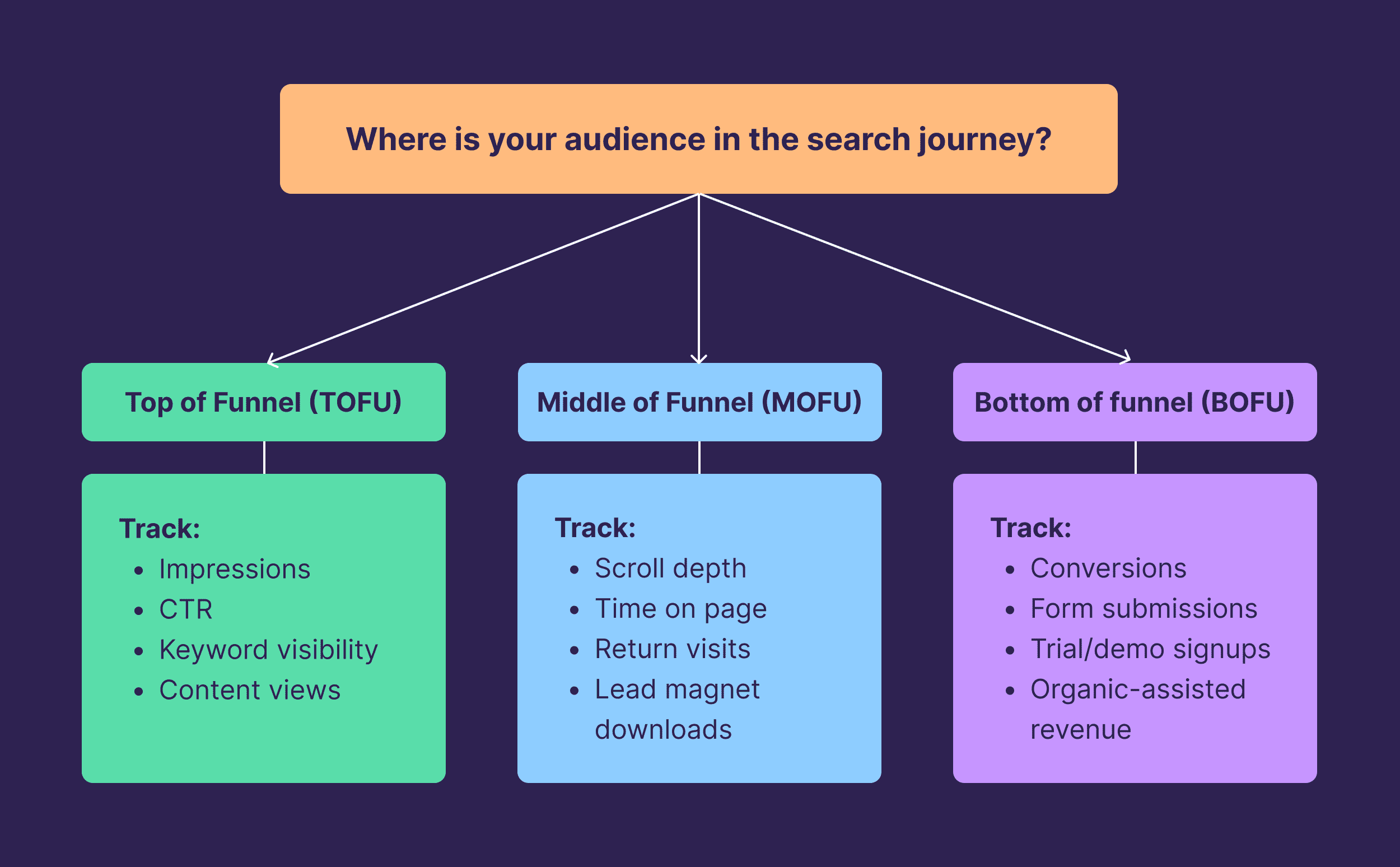
Think through the following questions:
- Where does your audience search at different points of the journey? Are they using Google, TikTok, Instagram, ChatGPT?
- How does your target audience search for your product or service? Are they typing in problem-based queries or searching by brand?
- Are they using Google’s AI Overviews (AIOs) to make decisions, or do they largely ignore them?
Once you have the answers to these questions, you can map out where your brand needs to be seen by your target audience.
Let’s say you have a complex product and your audience has a long sales journey, and they do a lot of research before they make their final decision via several channels.
Impressions across different search platforms, branded search increases, and on-page engagement would be better KPIs than immediate organic conversions or form opt-ins.
Alternatively, imagine your audience is high-intent, they don’t use LLMs as part of their search journey, and your site focuses on providing only bottom-of-funnel content. In this case, you’d want to focus on CTR and organic conversion metrics.
3. Define Strategic Business Outcomes
Your KPIs should reflect business outcomes you expect your strategy to influence.
I like to think of this in four major types of strategic SEO goals:
- Brand visibility
- Lead generation
- Revenue impact
- Authority building
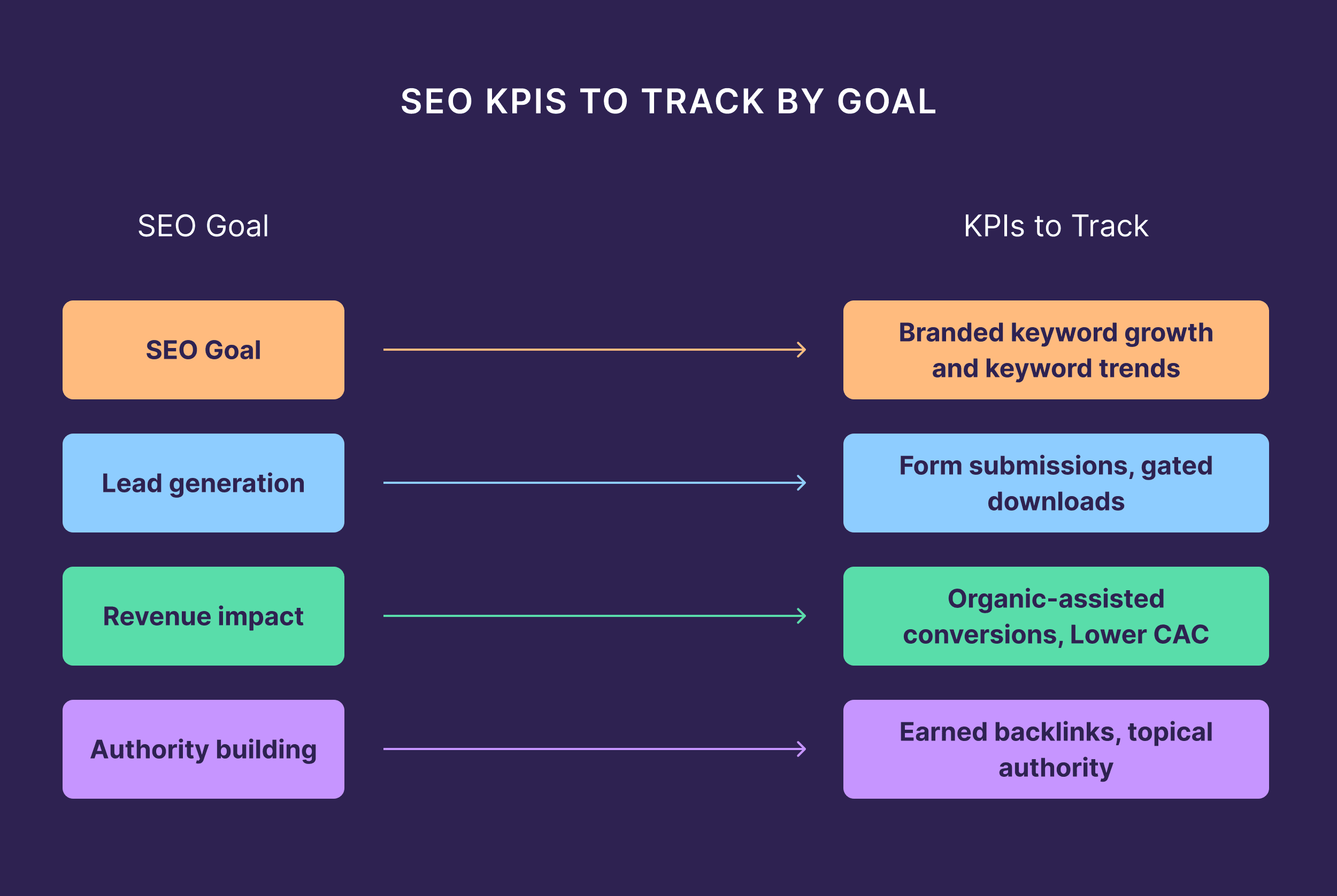
4. Match KPIs to Your Site’s SEO Maturity
You’ll also need to consider your KPIs based on your site’s SEO maturity stage.
If you’re in the early stage of SEO investment, you’ll want to zero in on:
- Content production goals: Report on the number of new blog posts or landing pages published per month.
- Keyword rankings: Track how many of your target keywords break into the top 20 search results.
- Visibility growth: Monitor the overall increase in impressions and clicks.
But if you’re further along in your SEO strategy?
Shift your focus from visibility to impact and trust.
If you’re in the advanced stages of SEO investment, rather than just asking “What’s improving?” ask yourself things like:
- How many pages rank in the top 10 from our entire content library?For example, if only 10% of your pages rank on page 1, you’ll want to monitor the topic clusters where you’re weakest and set a KPI to improve those over time.
- Which pages or topics convert best and why?Let’s say you have a post that drives five demo signups per month, but another page in a different topic cluster drives zero. As you work to better optimize your pages, track demo signup growth by topic to gauge improvement.
- Where do we see the least engagement?For example, if you’re experiencing high impressions but low average time on page in one particular topic cluster, your content may be missing the mark. Set a goal to optimize those pages and ensure you’re tracking on-page engagement as a KPI to determine which actions move the needle.
Track the Right SEO KPIs to Get Real Results
Now that you know what KPIs to track (and which metrics to ignore), you’ll want to do the following:
- Do a KPI audit: Are you tracking what really matters? Use the SEO KPIs planner to help you decide on the right ones for your business or client.
- Set a review cadence: Monitor your KPIs weekly, monthly, or quarterly based on your goals.
- Evolve as you grow: Your KPI mix should mature with your SEO strategy. You’ll measure different KPIs in year one of your SEO efforts vs. year three.
This will help you drive real SEO results. Results that grow your business and show your clients the impact of your SEO efforts.
Free resource: Remember to download our free SEO KPI planner to set yourself up for success.
Backlinko is owned by Semrush. We’re still obsessed with bringing you world-class SEO insights, backed by hands-on experience. Unless otherwise noted, this content was written by either an employee or paid contractor of Semrush Inc.




